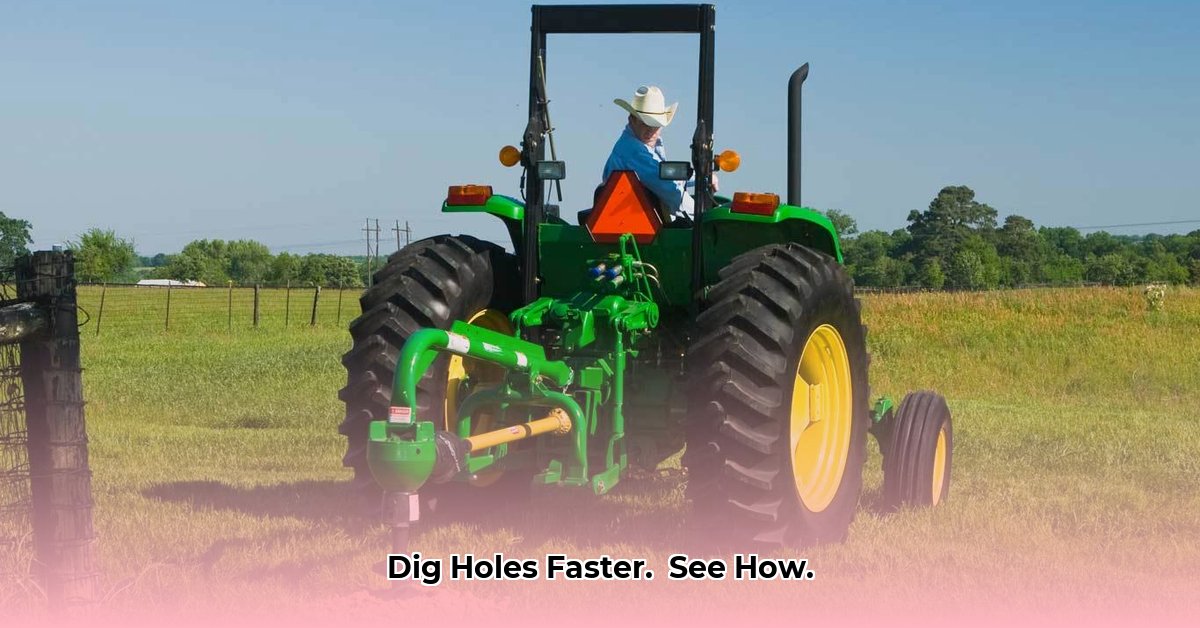
Digging post holes by hand is strenuous and time-consuming. A tractor-mounted post hole digger attachment offers a significantly faster and easier solution for various applications, from fencing to planting. This comprehensive guide will help you select the right attachment, install it correctly, and operate it safely and efficiently. For more information on tractor attachments, check out this helpful resource on tractor attachments.
Choosing the Right Post Hole Digger Attachment
Selecting the appropriate post hole digger begins with understanding your tractor's capabilities and your specific needs. Ignoring this crucial initial step can lead to inefficiency or even equipment damage.
Matching Digger to Tractor
Before exploring different models, consult your tractor's manual to determine its hydraulic flow rate and PTO (Power Take-Off) horsepower. These specifications dictate the digger's maximum size and power compatibility. Using a digger exceeding your tractor's capacity is dangerous and ineffective.
Auger Size and Soil Type
Consider the auger size (the spinning drill bit). Larger augers dig wider holes, ideal for rocky or compacted soil, but demand greater tractor power. Smaller augers are suitable for lighter soils and less powerful tractors. The soil type significantly impacts the auger size needed for optimal efficiency.
Usage Frequency and Budget
How often will you use the post hole digger? Occasional use justifies a simpler, more affordable model, while frequent use necessitates a robust, durable, and potentially more expensive digger designed for long-term reliability. Establish a clear budget beforehand to avoid overspending.
| Feature | Considerations |
|---|---|
| Tractor Capacity | Check your tractor's manual for hydraulic flow rate and PTO horsepower. This is critical for compatibility. |
| Auger Size | Larger augers need more power but handle tougher soils. Match to your soil type and tractor capabilities. |
| Frequency of Use | Infrequent use? Opt for a basic model. Frequent use demands a rugged, long-lasting digger. |
| Budget | Define your budget before starting your search to avoid impulse purchases. |
Attaching and Detaching the Post Hole Digger
Attaching the digger is typically straightforward, but always prioritize consulting your specific equipment's owner's manual. The following steps provide a general overview.
- Three-Point Hitch Engagement: Lower your tractor's three-point hitch (the system for lifting and lowering attachments).
- Precise Alignment: Carefully align the digger's mounting bracket with the hitch's lower links. Precise alignment is crucial for stability and safety.
- Hydraulic Connection: Securely connect the hydraulic lines, ensuring no leaks. Leaks can cause significant problems and pose a safety risk.
- Hydraulic Lift: Raise the digger using the tractor's hydraulics to confirm proper alignment.
- PTO Engagement: Engage the PTO (Power Take-Off) to power the auger. Double-check all connections for secure attachment.
Detaching the digger involves reversing these steps. Always disengage the PTO before disconnecting hydraulic lines to prevent accidents.
Operation and Maintenance for Optimal Performance
Efficient and safe operation involves pre-operation checks, careful handling, and regular maintenance.
Safe Operating Procedures
Before starting, clear the area around the tractor of obstacles and bystanders. Keep children and pets at a safe distance. Engage the auger slowly and smoothly, avoiding sudden movements. Maintain a consistent speed and depth for uniform holes. A sharp auger improves efficiency and reduces strain on the tractor.
Maintaining a consistent speed (approximately 100-120 RPM) is crucial for optimal hole formation and to minimize damage to the auger and tractor. Don't force the auger; adjust speed based on the soil's consistency.
Regular Maintenance for Longevity
Regular maintenance is vital for the lifespan of your post hole digger. Check the hydraulic fluid levels and lubricate moving parts according to the manufacturer's recommendations. Sharpen or replace worn augers promptly. Improper maintenance can greatly reduce lifespan and safety.
Weighing the Pros and Cons
Investing in a tractor-mounted post hole digger involves weighing its advantages against its drawbacks.
Pros:
- Increased Speed and Efficiency: Significantly faster than manual digging.
- Reduced Physical Strain: Less physically demanding than manual labor.
- Deeper Hole Capability: Easily digs much deeper holes.
- Enhanced Versatility: Some models can perform additional tasks.
Cons:
- Higher Initial Investment: Typically more expensive than handheld options.
- Tractor Dependency: Requires a tractor, restricting usage in certain situations.
- Ongoing Maintenance: Regular maintenance is essential.
- Significant Storage Space: Requires considerable storage space.
Key Takeaways: Maximizing Your Post Hole Digging Success
- Prioritize Compatibility: Always confirm your tractor's capabilities before purchasing a digger.
- Maintenance is Key: Regular inspection and maintenance significantly extend the digger's lifespan.
- Safety First: Follow all safety precautions before, during, and after operation.
By following these guidelines, you can confidently select, install, and operate your tractor-mounted post hole digger, ensuring efficient and safe post hole digging for years to come.